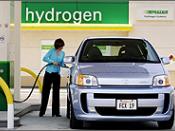From the earliest days of the automotive industry alternative fuels have always competed with petroleum for powering vehicles. Nicholas Cugnot made the first self-powered road vehicle in 1769 with a steam engine, and the first gasoline automobile didn't appear until over 100 years later from Karl Benz. Through the late 19th and early 20th century steam and electric power remained strong contenders. The invention of the self-starter for gasoline engines by Cadillac eventually proved the undoing of the early steam cars, which required warming up. Electric cars continued to be produced for a while longer, but the expanding road network gradually made their short range of 8-15 miles between charges too inconvenient for many uses.
Today we understand that the wholesale burning of petroleum can't continue forever. As the new century opens alternative fuel vehicles are becoming more and more common. Major manufacturers such as Ford, Daimler/Chrysler, and Fiat offer dual fuel cars and trucks now.
These vehicles allow you to choose between gasoline and compressed natural gas (CNG) for cleaner emissions. Other large manufacturers such as General Motors, Toyota, and Honda are concentrating on electric vehicles. These global automakers are slowly moving from conventional to alternative power as the technology is developed and refined. Current battery technology allows a maximum range of about 125 miles per charge.
The leading edge of electric vehicle technology is occupied by much smaller companies. Bombardier, Pivco AS, and S-LEM AG have designed small, lightweight city cars intended for daily use in dense urban environments. Corbin-Pacific and Zebra Motors have chosen to concentrate on performance. Both companies produce creditable sports cars that just happen to be electrically powered.
Do you have an idea that you think will work for an alternatively powered vehicle concept? The U.S. Department of Energy invites small businesses (500 employees...


